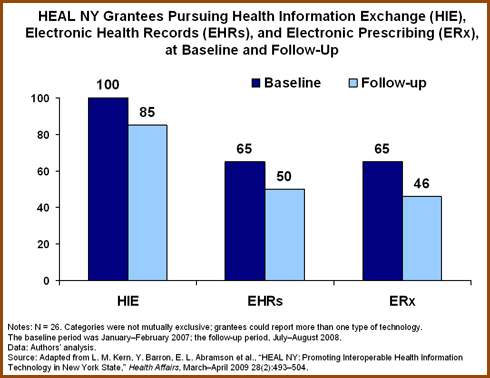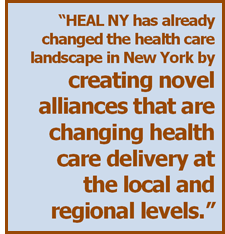Full text is available at:
http://content.healthaffairs.org/cgi/content/ full/28/2/493?ijkey=5gQUFsHX9E8I.&keytype=ref&siteid=healthaff
Synopsis
A program in New York has changed the state’s health care landscape by providing grants to regional alliances seeking to implement interoperable health information technology (IT). All alliances that received grants in 2006 remain operational, in contrast to the high failure rate found among similar groups in other states.

The Issue
Three-quarters of U.S. states are developing the capacity for electronic health information exchange (HIE) among health care organizations. HIE makes it possible to integrate health care information, improve the quality of care, and decrease costs. States have focused on implementing HIE through regional health care information organizations—alliances of physician practices, hospitals, pharmacies, laboratories, and other stakeholders—but a national study found that one-quarter of these entities closed within a year of start-up. With funding from the Healthcare Efficiency and Affordability Law for New Yorkers (HEAL NY) Capital Grants Program, New York State plans to invest $250 million in health IT, the largest state-based public investment of its kind, by awarding grants to health care stakeholders committed to implementing HIE, interoperable electronic health records, or electronic prescribing. Currently, $160 million in HEAL NY funds has been granted and $230 million in private sector dollars committed to health IT infrastructure, bringing New York’s investment to $390 million.
Key Findings
- HEAL NY grantees—typically community hospitals and physician practices—were distributed across all six regions of New York State and received an average of $1.8 million each.
- All grantees still existed and were implementing or attempting to implement interoperable health IT at follow-up. Half had reduced the number of projects they were pursuing.
- More than three-fourths of grantees were still pursuing HIE, half were still pursuing EHRs, and half were still pursuing e-prescribing. Only one-third of grantees had users, reflecting the newness of the initiatives and the difficulties of implementation.
- At follow-up, the most commonly cited barriers to sustainability were the need for stakeholder buy-in, lack of alignment of financial incentives, and funding concerns.
Addressing the Problem

Financial sustainability is a concern for communities implementing interoperable health IT. Robust reimbursement models are needed, including those that propose sharing costs and benefits across stakeholders. Newer-generation software applications that result in fewer workflow and other difficulties also will be necessary. Policymakers should be aware that it takes time for such technologies to produce positive clinical and economic outcomes, and that they must be aligned with health care delivery and reimbursement reforms to do so.
About the Study
The study included 26 grantees encompassing community hospitals, physician practices, health plans, long-term care facilities, home care agencies, and local public health departments from across the state. these received a total of $53 million in heal ny grants. a baseline assessment included 26 open-ended questions intended to characterize grantees’ progress in developing hie, electronic health records, and e-prescribing; structural issues, such as governance and sustainability; and expected impact. A follow-up assessment examined the proportion of grantees still pursuing initial projects.
The Bottom Line
HIE is a viable strategy for improving the quality and efficiency of care, but it requires policy support, technological building blocks, and clinical capacity, as well as financial and time commitments. HEAL NY represents a public-good funding model that can help offset communities’ upfront cost to implement HIE.


